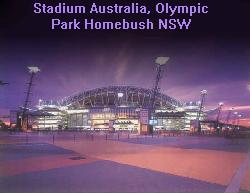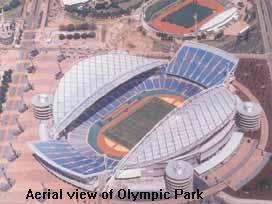
25th February 2001
Front Page|
News/Comment|
Editorial/Opinion| Business|
Sports| Mirror
Magazine

![]()








Building a winner
Building a stadium, is an operation second only to preparing for war, says Professor Lawrence Nield, the man who built, what head of the Olympic Committee, Juan Antonio Samaranch hailed as 'the world's greatest Olympic stadium ever'.
By Laila Nasry
An estimated five billion people the world over, watched in breathless anticipation as Australian athlete Cathy Freeman, carrying the Olympic torch aloft, was being raised to ignite the cauldron to signal the start of the Sydney 2000 Olympics. But at that moment, one man sitting in the stands thought he would pass out. For Cathy's ascent seemed to have stopped midway and he knew the pause was definitely not for effect. His wife sensing him start, asked worriedly, "What's happening Lawrence? What's going on?"
 It
was a moment the world never noticed. But for architect Professor Lawrence
Nield- who was in Sri Lanka last week to attend the annual sessions of
the Institute of Architects - that fraction of a second seemed like a lifetime.
Within seconds however, Cathy was lighting the Olympic flame and the stadium
was reverberating to the thunderous applause. Awe and excitement were written
all over the faces of his audience. For Prof. Nield, the feeling was one
of profound relief.
It
was a moment the world never noticed. But for architect Professor Lawrence
Nield- who was in Sri Lanka last week to attend the annual sessions of
the Institute of Architects - that fraction of a second seemed like a lifetime.
Within seconds however, Cathy was lighting the Olympic flame and the stadium
was reverberating to the thunderous applause. Awe and excitement were written
all over the faces of his audience. For Prof. Nield, the feeling was one
of profound relief.
"A television station was setting up their equipment and one of the cables had come loose and the mechanism had to be worked manually," he explained recalling that agonising moment. However such moments are few for Professor Nield, the man who built, what head of the Olympic Committee, Juan Antonio Samaranch hailed as 'the world's greatest Olympic stadium ever'.
Building a stadium, he says, is an operation second only to preparing for war. For it's not just about building a stadium, but an entirely new city. Twenty designers in all, from the firm Bligh Voller Nield prepared a brief for six long months. "We wanted the language of the new city to speak of dynamism. Something that would excite the people and get them wanting to come into the stadium." They were one of the six contenders vying for a place in history.
There was no conflict of interest despite the fact that Professor Nield had already been deployed as an advisor to the Aussie Government for the Olympic site and later headed the Olympic Co-ordinating Authority for the site's masterplan. "It's like a lottery," Professor Nield says of the bid. "The pitching was competitive, the wait nail-biting and the victory of landing it, sweet. The briefs were narrowed down from six to four to two and then one-us."
 The
drawing of the plan and the construction was done concurrently. "There
was no time to change our minds, which was good," Professor Nield
says, smiling.
The
drawing of the plan and the construction was done concurrently. "There
was no time to change our minds, which was good," Professor Nield
says, smiling.
However, the design challenge stemmed from understanding the Olympic tradition. "We visited a lot of stadiums and studied past Olympic briefs."
The International Olympic Committee gave very strict specifications when it came to drawing up a design plan. "They've been going on for more than 100 years and they know pretty much what they want. The geometry of the sidelines, the place for shot putters, seating for 80,000 people, a separate enclosure for the journalists etc." The budget was set at Aus. $ 500,000,000.
Professor Nield and his team went beyond expectations. Their design was creativity personified with innovations such as increasing the seating capacity to 110,000. The construction was partly funded by the government, the rest through membership. "We marketed the additional seats at a membership fee of Aus. $10,000 each, which could be utilised for the football games, cricket matches and concerts to be held at the stadium eventually."
Further the lower seats were built on rails "to enable the spectators to close-in on the field of play," Professor Nield said.
 While
some couldn't provide a roof within the budget, theirs came with one. The
roof was all steel covering a space of 30,000 sq. m., weighing 4,100 tonnes,
with no columns to support it. "They were great big arches, most made
in little towns situated 500 km outside Sydney and transported on the back
of a lorry." The arches were the underlying theme throughout the entire
stadium. The roof was translucent, allowing maximum natural light during
daytime, at the same time providing effective sun and rain protection for
the spectators (except for the temporary seats).
While
some couldn't provide a roof within the budget, theirs came with one. The
roof was all steel covering a space of 30,000 sq. m., weighing 4,100 tonnes,
with no columns to support it. "They were great big arches, most made
in little towns situated 500 km outside Sydney and transported on the back
of a lorry." The arches were the underlying theme throughout the entire
stadium. The roof was translucent, allowing maximum natural light during
daytime, at the same time providing effective sun and rain protection for
the spectators (except for the temporary seats).
Stadium Australia was very much a 'green' one, designed to ensure environmental sustainability. The rain water collected on the roof was to be utilised to water the grass, flush the toilets, etc. Passive ventilation, which is ventilation without any mechanical devices was integrated into the design thereby minimising the extent of air-conditioning used.
The complex was a host of white buildings designed to blend with the Australian weather. "One of the needs of modern sporting is to be able to put on a show," Prof. Nield explained. Thus a big studio was designed to maximise the total entertainment experience.
In September 1996, construction began. The site was 760 sprawling hectares in Homebush Bay, Sydney, 15 km away from the great Pacific Ocean. The original building, a crumbling abattoir was sacrificed, domestic and industrial rubbish removed and electric cables moved to make way for the world's most magnificent sporting arena.
The four-year time factor for construction was never in question. "You have to finish it. It simply can't run late."
All the same, once again Prof. Nield and his team sprang a surprise when in March 1999 almost 11/2 years before the deadline, the construction of the biggest stadium came to an end. "Australia has a skilled building industry," Prof. Nield says nonchalantly.
Currently he is involved with the 2004 Athens Olympics construction, a dream come true having always wanted to be involved in designing and constructing sporting structures. "It's a mix between people, an event and the best possible way of seeing it." He is also helping Toronto and Buenos Aires prepare for the 2008 and 2012 Olympics respectively by contributing his expertise and experience towards preparing their briefs.
Whoever said one has be an Ian Thorpe or a Maurice Greene to make one's mark in the Olympic world?
![]()
Front Page| News/Comment| Editorial/Opinion| Plus| Business| Sports| Mirror Magazine
Please send your comments and suggestions on this web site to

